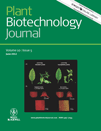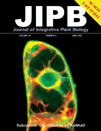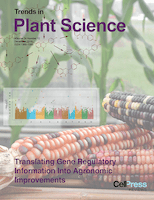
Nature Plants
Scope & Guideline
Fostering Innovation in Agriculture and Ecology
Introduction
Aims and Scopes
- Plant Genetics and Genomics:
Research on the genetic basis of plant traits, including studies on genome sequencing, gene editing (such as CRISPR and prime editing), and the exploration of genetic diversity in crops and wild relatives. - Plant Physiology and Biochemistry:
Investigations into the biochemical processes within plants, including photosynthesis, stress responses, and metabolic pathways that contribute to growth and development. - Plant-Microbe Interactions:
Studies focusing on the interactions between plants and microorganisms, including beneficial symbionts and pathogens, and how these interactions influence plant health and productivity. - Ecology and Evolutionary Biology:
Research examining the ecological roles of plants, their evolutionary history, and responses to environmental changes, including climate change and habitat loss. - Agricultural Innovations and Crop Improvement:
Applied research aimed at improving crop yields and resilience through biotechnological methods, sustainable practices, and understanding plant traits that enhance agricultural productivity. - Plant Development and Morphogenesis:
Exploration of the developmental processes in plants, including cell differentiation, organ formation, and the genetic and environmental factors that influence these processes.
Trending and Emerging
- CRISPR and Genome Editing Technologies:
The application of CRISPR and other genome editing technologies is rapidly increasing. This includes studies focused on precise modifications to enhance crop traits, improve disease resistance, and facilitate research on plant biology. - Microbiome Research in Plants:
There is a growing interest in understanding the plant microbiome and its role in plant health and productivity, including how microbial communities influence disease resistance and nutrient uptake. - Climate Change Resilience and Adaptation:
Research addressing how plants adapt to climate change is trending, focusing on physiological, genetic, and ecological mechanisms that enhance resilience to stressors such as drought and heat. - Synthetic Biology and Plant Engineering:
The use of synthetic biology approaches to create novel traits in plants is gaining traction, with papers discussing engineered pathways and synthetic circuits that improve plant function. - Interdisciplinary Approaches Combining Plant Science with AI and Big Data:
The integration of artificial intelligence and big data analytics in plant science research is on the rise, facilitating advancements in precision agriculture, crop modeling, and trait prediction. - Plant Defense Mechanisms and Immune Responses:
Research into the molecular and genetic basis of plant defense mechanisms against biotic stresses, including pathogens and herbivores, is increasingly prominent, reflecting the importance of plant immunity.
Declining or Waning
- Traditional Breeding Techniques:
While traditional breeding methods were once a staple of agricultural research, the recent surge in genetic engineering and CRISPR technologies has overshadowed these methods. Studies focusing solely on conventional breeding practices are less frequent. - Basic Botanical Taxonomy and Classification:
Research dedicated to the classification and naming of plants has seen declining interest as the focus shifts towards functional genomics and ecological interactions, which provide more immediate applications in conservation and agriculture. - Historical Plant Uses and Ethnobotany:
Although important, studies centered on historical uses of plants and ethnobotanical knowledge are becoming less common, as contemporary research increasingly prioritizes genetic and biochemical approaches. - Soil Science and Plant Nutrition:
Research specifically focusing on soil chemistry and nutrition has diminished relative to studies that integrate these aspects into broader ecological and molecular frameworks. - Plant Pathology with Emphasis on Historical Disease Outbreaks:
Research concentrating on historical plant diseases is waning as the focus shifts towards understanding contemporary threats and developing modern disease resistance strategies through genetic approaches.
Similar Journals

PLANT BIOTECHNOLOGY JOURNAL
Driving progress in plant biotechnology for global impact.Plant Biotechnology Journal, published by Wiley, is a premier open-access platform dedicated to advancing the field of plant biotechnology. Since its inception in 2003, this journal has played a pivotal role in disseminating high-quality research that enhances our understanding of plant genomics, biochemistry, and molecular biology. With an impressive impact factor and a prominent position in Q1 quartiles across Agronomy, Crop Science, Biotechnology, and Plant Science, it ranks among the top journals globally, reflecting its significant influence in the agricultural and biological sciences. Researchers and professionals can access cutting-edge studies and reviews that facilitate innovation in sustainable crop production and biotechnology applications. The journal's transition to an open access model since 2016 has further amplified its reach, ensuring that vital research is available to a global audience, promoting collaboration and knowledge sharing within the scientific community.

Annual Plant Reviews Online
Connecting Research and Innovation in Plant BiologyAnnual Plant Reviews Online, published by WILEY, serves as a premier academic resource dedicated to the evolving field of plant sciences, including specialties in agronomy, horticulture, and food science. With an impressive Q1 ranking in Horticulture and Q2 classifications in Agronomy, Crop Science, and Plant Science, this journal reflects a high standard of scholarly contribution, evidenced by its positioning in the 75th percentile range among agricultural and biological sciences in leading Scopus rankings. Aimed at researchers, professionals, and students alike, the journal covers a broad spectrum of plant-related topics and trends, aiming to enhance the understanding of plant biology and its applications. Offering timely insights and critical reviews, Annual Plant Reviews Online connects the global community with essential knowledge, supporting advancements in sustainable practices and innovations in agriculture. Researchers and students can access its content seamlessly, contributing to ongoing discussions in plant science and fostering academic growth.

AMERICAN JOURNAL OF BOTANY
Fostering Innovation in Ecology and Plant GeneticsAmerican Journal of Botany, an esteemed publication by Wiley, serves as a pivotal platform for the dissemination of groundbreaking research in the fields of botany, ecology, plant science, and genetics. With an illustrious history dating back to 1946, this journal holds a prestigious position in the academic community, evident through its Q1 ranking in both Ecology, Evolution, Behavior and Systematics and Plant Science, alongside a Q2 ranking in Genetics as of 2023. The journal maintains a competitive edge, ranked 159th in Ecology and Evolution and 124th in Plant Science according to Scopus metrics, underscoring its impact within the research landscape. Though traditionally not an open-access journal, it continues to provide valuable insights and advancements in botanical science, making it essential reading for researchers, professionals, and students dedicated to understanding and exploring the complexities of plant life. The journal's commitment to high-quality research ensures that it remains a cornerstone in the pursuit of knowledge in botany and related disciplines.

Journal of Integrative Plant Biology
Empowering Researchers with Open Access InsightsThe Journal of Integrative Plant Biology, published by WILEY, is a premier academic journal that has been at the forefront of advancing research in plant biology since its inception in 2005. With a notable impact factor and a robust Scopus ranking—positioned at #7 out of 516 in Plant Science and #18 out of 438 in Biochemistry—this journal is recognized as a Q1 journal in multiple categories, including Biochemistry and Plant Science. The journal aims to bridge the gaps between various disciplines in plant research, emphasizing integrative and interdisciplinary approaches to understanding plant biology. With options for open access, the Journal of Integrative Plant Biology ensures broad visibility and impact of research findings, making it an invaluable resource for researchers, professionals, and students looking to stay informed on innovative advancements in the field. Its headquarters are located in the United Kingdom, further amplifying its reach within the global academic community.

Egyptian Journal of Botany
Exploring the depths of ecological research.Egyptian Journal of Botany is a premier publication in the field of botanical sciences, encompassing agricultural research, plant biology, and ecology. Published by the NATL INFORMATION DOCUMENTATION CENT, ACAD SCIENTIFIC RESEARCH & TECHNOLOGY in Egypt, this journal has made significant strides since its establishment, now recognized within several prestigious Scopus quartiles including Q3 in Agronomy and Crop Science, and Q3 in Ecology, reflecting its impact and relevance in the scientific community. With an aim to disseminate high-quality research and foster innovation in plant sciences, the journal provides a platform for researchers, professionals, and students alike to share vital findings and advancements. Although it currently operates under traditional access, the wealth of knowledge it offers is pivotal for those engaged in ecological preservation, crop improvement, and biotechnological applications. With its comprehensive scope and evolving reputation, the Egyptian Journal of Botany is poised to remain an influential player in the botanical sciences from 2019 to 2024 and beyond.

NEW PHYTOLOGIST
Unraveling the Complexities of Plant LifeNEW PHYTOLOGIST is a premier international journal published by WILEY, focusing on the field of plant science and physiology. Operating since 1902, this esteemed journal has established itself as a vital resource for researchers and professionals alike, offering cutting-edge research and insights into the complex workings of plants and their physiological processes. With an impressive impact factor and recognized in the top quartile (Q1) of both the physiology and plant science categories, it ranks #8 and #9 respectively in their fields, placing it within the top 2% of journals. NEW PHYTOLOGIST is not only essential for enhancing the understanding of plant biology but also for addressing global challenges such as food security and environmental sustainability. Although it does not currently offer open access, the journal remains committed to disseminating knowledge to a wide audience through institutional subscriptions and partnerships. This journal continues to drive advancements in plant science into the future, making it an invaluable asset for students, researchers, and industry professionals.

AoB Plants
Fostering collaboration in plant science research.AoB Plants is a distinguished open-access journal published by Oxford University Press, dedicated to advancing the field of plant science. Since its inception in 2009, this journal has played a pivotal role in disseminating high-quality research that encompasses a wide range of topics including plant biology, ecology, and biotechnology. With an impressive impact factor and a ranking in the Q1 quartile for Plant Science, AoB Plants is recognized for its innovative contributions and scholarly rigor, ranking #129 out of 516 in the Scopus Agricultural and Biological Sciences category, placing it in the 75th percentile among its peers. By promoting open-access availability of research findings, the journal empowers researchers and practitioners alike, facilitating greater collaboration and knowledge sharing in the global scientific community. Situated in the heart of the United Kingdom, AoB Plants continues its commitment to providing a platform for pioneering research and developments in plant science, thus fostering a deeper understanding of the crucial roles that plants play in our ecosystems and economies.

TRENDS IN PLANT SCIENCE
Exploring the Frontiers of Plant BiologyTRENDS IN PLANT SCIENCE is a premier academic journal published by CELL PRESS, dedicated to advancing the field of plant sciences. With an ISSN of 1360-1385 and E-ISSN 1878-4372, this journal has established itself as a critical resource for researchers and practitioners alike, boasting a remarkable impact factor that places it in the Q1 quartile for plant science in the 2023 rankings. Featuring a comprehensive scope that encompasses emerging trends, innovative research, and pivotal reviews in the plant sciences, it aims to promote interdisciplinary dialogue and encourage progressive research methodologies. Hailing from the United Kingdom, TRENDS IN PLANT SCIENCE serves a global community of over 516 journals, achieving a top-tier ranking of 3rd in the Scopus ranking for Agricultural and Biological Sciences. This makes the journal an indispensable asset for anyone aiming to keep abreast of the latest developments in plant biology and its applications. As we look towards its future converging years from 1996 to 2024, the journal continues to foster scholarly excellence and innovation in the field.

Plant Science Today
Fostering breakthroughs in ecological and plant research.Plant Science Today is a prominent journal dedicated to advancing the field of plant sciences through innovative research and comprehensive reviews. Published by HORIZON E-PUBLISHING GROUP in India, this open-access journal has been actively disseminating knowledge since its inception in 2018, with a convergence period extending to 2024. With an ISSN of 2348-1900 and a growing reputation, it is categorized in various quartiles for 2023, notably achieving Q3 in Biochemistry, Genetics and Molecular Biology (miscellaneous), while it holds Q4 rankings in critical fields including Ecology and Plant Science. As a valuable resource for students, researchers, and professionals, Plant Science Today aims to inspire discussion and innovation in the realm of ecological and plant science disciplines, where it currently ranks within the lower percentiles in prominent categories such as Environmental Science and Agricultural and Biological Sciences. The journal serves as a crucial platform for the exploration of experimental and theoretical advances, fostering a community eager to explore plant biology's complexities.

BANGLADESH JOURNAL OF BOTANY
Bridging Science and Conservation in Plant StudiesBANGLADESH JOURNAL OF BOTANY is a prominent publication in the field of plant sciences, dedicated to advancing research and knowledge within the botanical community. Published by the BANGLADESH BOTANICAL SOC, this journal serves as a vital platform for researchers and scholars seeking to disseminate their findings related to plant biology, ecology, and conservation practices, particularly within the unique context of Bangladesh's diverse flora. With an ISSN of 0253-5416 and an E-ISSN of 2079-9926, the journal encompasses a wide scope of topics, reflecting interdisciplinary approaches in botanical research. Since its inception, with convergence periods from 1996 to 2001 and from 2003 to 2024, it has garnered recognition, positioned in the Q4 category in the Plant Science field with a ranking of #459/516 in Scopus, indicating its contribution to the field despite its developing impact. Operating within Bangladesh, at the UNIV DACCA DEPT BOTANY, the journal provides a crucial insight into the ecological and agricultural implications of plant studies in the region, catering to the needs of academics, professionals, and students eager to engage with contemporary botanical research.